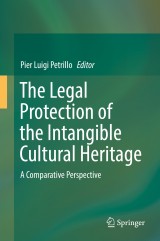Details

The Legal Protection of the Intangible Cultural Heritage
A Comparative Perspective|
160,49 € |
|
| Verlag: | Springer |
| Format: | |
| Veröffentl.: | 26.06.2019 |
| ISBN/EAN: | 9783319729831 |
| Sprache: | englisch |
Dieses eBook enthält ein Wasserzeichen.
Beschreibungen
<div>This book describes the global legal framework for safeguarding the “Intangible Cultural Heritage” – as defined by the UNESCO Convention in 2003 – and analyses its use in selected countries in the Americas, Asia, Africa and Europe. Each of the contributions has been prepared by high profile experts and strategically addresses countries that are representative for their corresponding area. Our understanding of the term “Cultural Heritage” has changed considerably over the past few decades, and it is becoming increasingly clear that the concept also includes traditions and living expressions that we inherit from our ancestors and pass on to our descendants. UNESCO has recognised and responded to this change of perspective, creating through the 2003 Convention an international instrument for safeguarding the “Intangible Cultural Heritage”, a notion including oral traditions, performing arts, social practices, rituals, festive events, knowledge and practices concerning nature and the universe, as well as the knowledge and skills needed to produce traditional crafts. New values, practices and heritages were recognized – from the ancient African rituals to the Mexican Mariachi musical expression to the Brazilian Samba and the Mediterranean Diet – all of which convey strong social and cultural meaning for their community's identity. Intangible Cultural Heritage is a growing, relatively recent field of study and also an emblem of the dialogue between distant populations with different cultures, which is the reason why a comparative approach is the most appropriate basis for conducting an analysis of how the contracting states to the Convention live up to their commitments through national safeguarding measures and enhancement policies or through international cooperation projects.<br></div><div><br></div>
Part I Introduction.- Part II America.- Part III Asia.- Part III Africa.- Part IV Middle East and Africa.- Part V Europe.- Part VI Conclusions.
<b>Pier Luigi Petrillo</b> is full Professor of Comparative Law, Unitelma Sapienza University of Rome, Italy. He is the author of Forme di governo e forme di opposizione nei nuovi Statuti regionali (Minerva, 2006); IRAN (Il Mulino 2008); Democrazie sotto pressione. Parlamenti e lobbies nel diritto pubblico comparato (Giuffrè 2010).
This book describes the global legal framework for safeguarding the “Intangible Cultural Heritage” – as defined by the UNESCO Convention in 2003 – and analyses its use in selected countries in the Americas, Asia, Africa and Europe. Each of the contributions has been prepared by high profile experts and strategically addresses countries that are representative for their corresponding area. Our understanding of the term “Cultural Heritage” has changed considerably over the past few decades, and it is becoming increasingly clear that the concept also includes traditions and living expressions that we inherit from our ancestors and pass on to our descendants. UNESCO has recognised and responded to this change of perspective, creating through the 2003 Convention an international instrument for safeguarding the “Intangible Cultural Heritage”, a notion including oral traditions, performing arts, social practices, rituals, festive events, knowledge and practices concerning nature and the universe, as well as the knowledge and skills needed to produce traditional crafts. New values, practices and heritages were recognized – from the ancient African rituals to the Mexican Mariachi musical expression to the Brazilian Samba and the Mediterranean Diet – all of which convey strong social and cultural meaning for their community's identity. Intangible Cultural Heritage is a growing, relatively recent field of study and also an emblem of the dialogue between distant populations with different cultures, which is the reason why a comparative approach is the most appropriate basis for conducting an analysis of how the contracting states to the Convention live up to their commitments through national safeguarding measures and enhancement policies or through international cooperation projects.
<p>Presents the first comparative law book on safeguarding the UNESCO Convention for the Safeguarding of the Intangible Cultural Heritage and its implementation at the national level</p><p>Analyses 10 case studies to help readers understand the differences between various legal systems around the globe</p><p>Demonstrates an innovative comparative approach to clarifying the different legal strategies in the context of intangible cultural heritage</p>
<div>Presents the first comparative law book on safeguarding the UNESCO Convention for the Safeguarding of the Intangible Cultural Heritage and its implementation at national level</div><div>Analyses 13 case studies for a better understanding of the differences between the various legal systems around the globe</div><div>Demonstrates an innovative comparative approach to clarify the different legal approaches in the context of intangible cultural heritage</div><div><br></div>
Diese Produkte könnten Sie auch interessieren:

Spreading Democracy and the Rule of Law?

von: Wojciech Sadurski, Adam Czarnota, Martin Krygier

149,79 €















